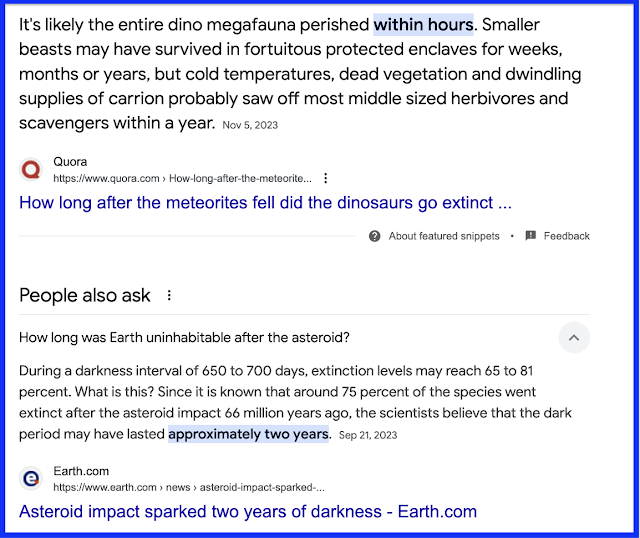*************************
The Book Page
The three books this week:
- When Life Nearly Died: The Greatest Mass Extinction of All Time, Michael J. Benton, c. 2003.
- Dinosaurs Rediscovered: The Scientific Revolution in Paleontology, Michael J. Benton, c. 2019.
- Gorgon: Paleontology, Obsession, and the Greatest Catastrophe in Earth's History, Peter D. Ward, c. 2004.
Some questions, areas to be explored:
- clade vs phylum
- the relationship between amphibians and reptiles, and between reptiles and mammals at the juncture of the Permian - Triassic periods
- the length of time over which the entire dinosaur megafauna died: maybe within hours
- the Permian - Triassic extinction was fast, but not that fast -- maybe 100,000 years
- the cause of the P-T extinction -- the greatest extinction event ever
- the Triassic was "red"; the Jurassic was "yellow." Why?
- along the way, we'll learn about buckyballs (buckerminster fullerenes) and GSSPs.
A Global Boundary Stratotype Section and Point (GSSP), sometimes referred to as a golden spike, is an internationally agreed upon reference point on a stratigraphic section which defines the lower boundary of a stage on the geologic time scale.
The effort to define GSSPs is conducted by the International Commission on Stratigraphy, a part of the International Union of Geological Sciences.
Most, but not all, GSSPs are based on paleontological changes. Hence GSSPs are usually described in terms of transitions between different faunal stages, though far more faunal stages have been described than GSSPs.
The GSSP definition effort commenced in 1977. As of 2024, 79 of the 101 stages that need a GSSP have a ratified GSSP.
*****************************
Planning For Retirement
Thinking it important enough for his two older daughters to start learning about personal finance, their father has the four of us (the two older daughters, him, and me) meet weekly in a video conference to talk about personal finance. The primary source material is same source material that the Harvard Business School uses.
The first chapter was an introductory chapter; the second chapter discussed the importance of learning about personal finance. Somewhere in there was a sidebar with Stephen Covey and The 7 Habits of Highly Effective People. I had taken the formal Covey course some years ago under the auspices of the USAF. I have found myself referring to Covey quite often over the years.
The third week was about budgeting and record keeping. Although it was only supposed to be one week long with one video conference it proved so interesting, the chapter was stretched to two weeks and two "zoom" meetings.
This week, there will be yet another week on budgeting and record keeping, a continuation of the discussion, but this week, the homework will require coming up with a budget and exploring the various tools available for budgeting and record keeping.
There must a gazillion ways to budget, including "do nothing and hope for the best" (DNAH) method. Dave Ramsay famously had his envelopes.
Over the years, I've used many different budgeting methods, but for quite some time now, I don't do any formal budgeting. Budgeting is pretty much ingrained in my everyday life, and so I was skeptical that going through the process [again] was unnecessary. But it was "homework" and I felt I needed to play along if I wanted to be part of the foursome.
It turns out that the exercise was incredibly beneficial. I came up with a notional budget and came up with a lot of observations and comments I can share with the two granddaughters.
One granddaughter has one more semester of college before graduating (December, 2025), She has a job lined up and begins working next year (2025).
The other granddaughter starts college this next month (September, 2024).
More later.

